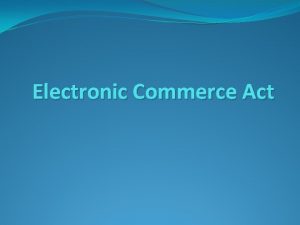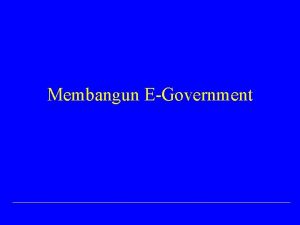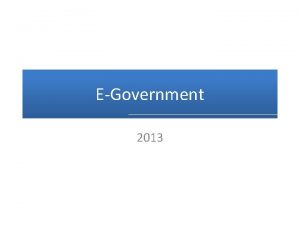What is egovernment EGovernment refers to the use




- Slides: 4

What is e-government? E-Government refers to the use by government agencies of information technologies (such as Wide Area Networks, the Internet, and mobile computing) that have the ability to transform relations with citizens, businesses, and other arms of government. These technologies can serve a variety of different ends: better delivery of government services to citizens, improved interactions with business and industry, citizen empowerment through access to information, or more efficient government management. The resulting benefits can be less corruption, increased transparency, greater convenience, revenue growth, and/or cost reductions.

Digital signature a digital signature is an electronic rather than a written signature that can be used by someone to authenticate the identity of the sender of a message or of the signer of a document. It can also be used to ensure that the original content of the message or document that has been delivered is unchanged.

How can e-government help corruption? Amongst the many tools being developed to fight against corruption, lately there has been much focus on e-government -using Information and Communication Technology (ICT) to open up government processes and enable greater public access to information. Usage of the term e-government is of recent origin and there is no commonly accepted definition. E-Government is understood as the use of emerging ICTs like Internet, World Wide Web and mobile phones to deliver information and services to citizens and businesses. It can include publication of information about government services on a web site, for example so that citizens can download application forms for a variety of services. It can also involve the actual delivery of services, such as filing a tax return, renewing a license, etc. More sophisticated applications include processing on-line payments.

In developed countries, these services are offered in a self-service mode through Internet Portals that are a single point of interaction for the citizen to receive services from a large number of departments. In developing countries, on-line services counters may operate in a department offering services related only to that department. In some countries, citizen service centers have been created at convenient locations where citizens can access on-line services of several departments. These counters are operated by department/private operators, and the citizens do not directly interact with computer screens. Collection of payments is often then handled through conventional means. In addition to such service centers, citizens may also be able to access service delivery portals The benefits to citizens and businesses from on-line delivery of services include convenience (location and time) and shorter waiting periods. In addition, E-Government systems may lead to greater transparency, resulting in reduced administrative corruption







